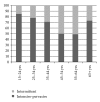Health and functional status of adults with intellectual disability referred to the specialist health care setting: a five-year experience
- PMID: 22295183
- PMCID: PMC3263836
- DOI: 10.1155/2011/312492
Health and functional status of adults with intellectual disability referred to the specialist health care setting: a five-year experience
Abstract
Aims and Method. The Developmental Disability Database in the Department of Rehabilitation Medicine at a metropolitan hospital was audited for observations on adults with Intellectual Disability living in the local region (total population 180,000) who were seen in an identified multidisciplinary specialist clinic, during 2006-2010. Results. There were 162 people (representing half the known number of adults with Intellectual Disability living in the region): 77 females, 85 males, age range 16-86 years. The most common complex disabilities referred to the specialists in this clinic were epilepsy (52%), challenging or changing behavior (42%) and movement disorders (34%). Early onset dementia was a feature of the group (7%). The prevalence of prescription of medications for gastro-oesophageal reflux was high (36%) and similar to the numbers of people taking psychotropic medications. The rates of chronic cardiovascular disease (2%), chronic respiratory disease (10%) and generalised arthritis (11%) were low overall, but did rise with increasing age. Conclusions. Complex neurological disabilities are common, and chronic medical illnesses are uncommon in adults with Intellectual Disability referred to specialist clinicians in this region. A combined, coordinated, multidisciplinary clinic model addresses some of the barriers experienced by adults with Intellectual Disability in the secondary health system.
Figures
Similar articles
-
Identifying individuals with intellectual disability who access mental health support and are at high risk for adverse clinical outcomes: cohort study.BJPsych Open. 2023 Oct 10;9(6):e183. doi: 10.1192/bjo.2023.574. BJPsych Open. 2023. PMID: 37813547 Free PMC article.
-
Seizure-related complication rate in a residential population with epilepsy and intellectual disability (ECOMRAID-trial).Epilepsy Behav. 2023 Mar;140:108995. doi: 10.1016/j.yebeh.2022.108995. Epub 2023 Feb 21. Epilepsy Behav. 2023. PMID: 36822042 Clinical Trial.
-
Challenging behavior and related factors in people with intellectual disability living in residential care centers in Israel.Front Public Health. 2013 May 21;1:13. doi: 10.3389/fpubh.2013.00013. eCollection 2013. Front Public Health. 2013. PMID: 24350182 Free PMC article.
-
Services for patients with intellectual disability and mental health problems in Poland.Psychiatr Danub. 2019 Sep;31(Suppl 3):534-542. Psychiatr Danub. 2019. PMID: 31488787 Review.
-
Ageing and mental health problems in people with intellectual disability.Curr Opin Psychiatry. 2007 Sep;20(5):467-71. doi: 10.1097/YCO.0b013e328278520d. Curr Opin Psychiatry. 2007. PMID: 17762589 Review.
References
-
- Wullink M, Van Schrojenstein Lantman-de Valk HMJ, Dinant GJ, Metsemakers JFM. Prevalence of people with intellectual disability in the Netherlands. Journal of Intellectual Disability Research. 2007;51(7):511–519. - PubMed
-
- Mulvany F, Barron S. Annual Report of the National Intellectual Disability Database Committee. Dublin, Ireland: Health Research Board; 2002.
-
- AIHW. Disability in Australia: intellectual disability. Bulletin 67 Australian Institute of Health and Welfare Canberra, 2008.
-
- Bittles AH, Petterson BA, Sullivan SG, Hussain R, Glasson EJ, Montgomery PD. The influence of intellectual disability on life expectancy. Journals of Gerontology. 2002;57(7):M470–M472. - PubMed
-
- Lennox N, Bain C, Rey-Conde T, Purdie D, Bush R, Pandeya N. Effects of a comprehensive health assessment programme for Australian adults with intellectual disability: A cluster randomized trial. International Journal of Epidemiology. 2007;36(1):139–146. - PubMed
LinkOut - more resources
Full Text Sources




